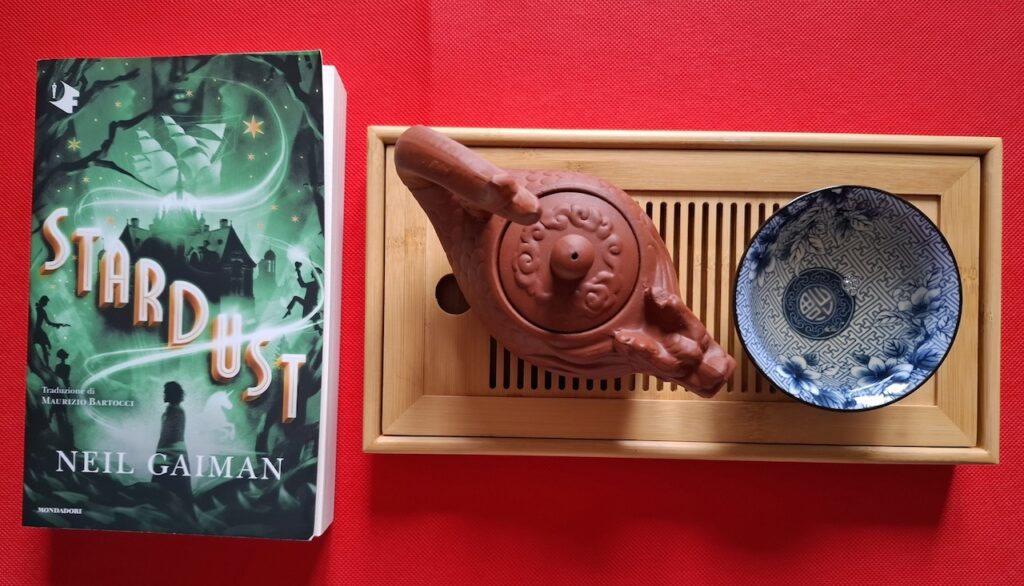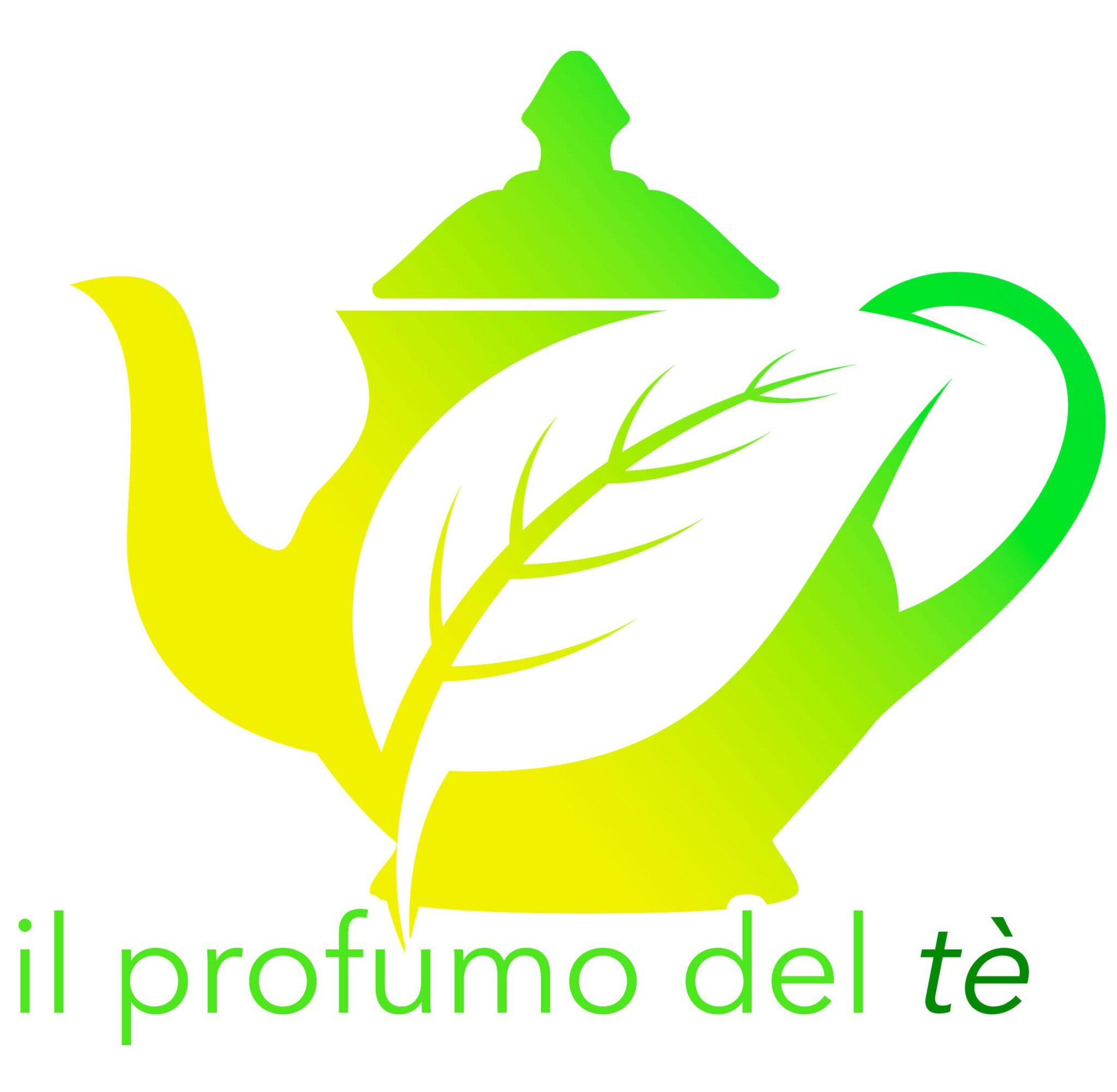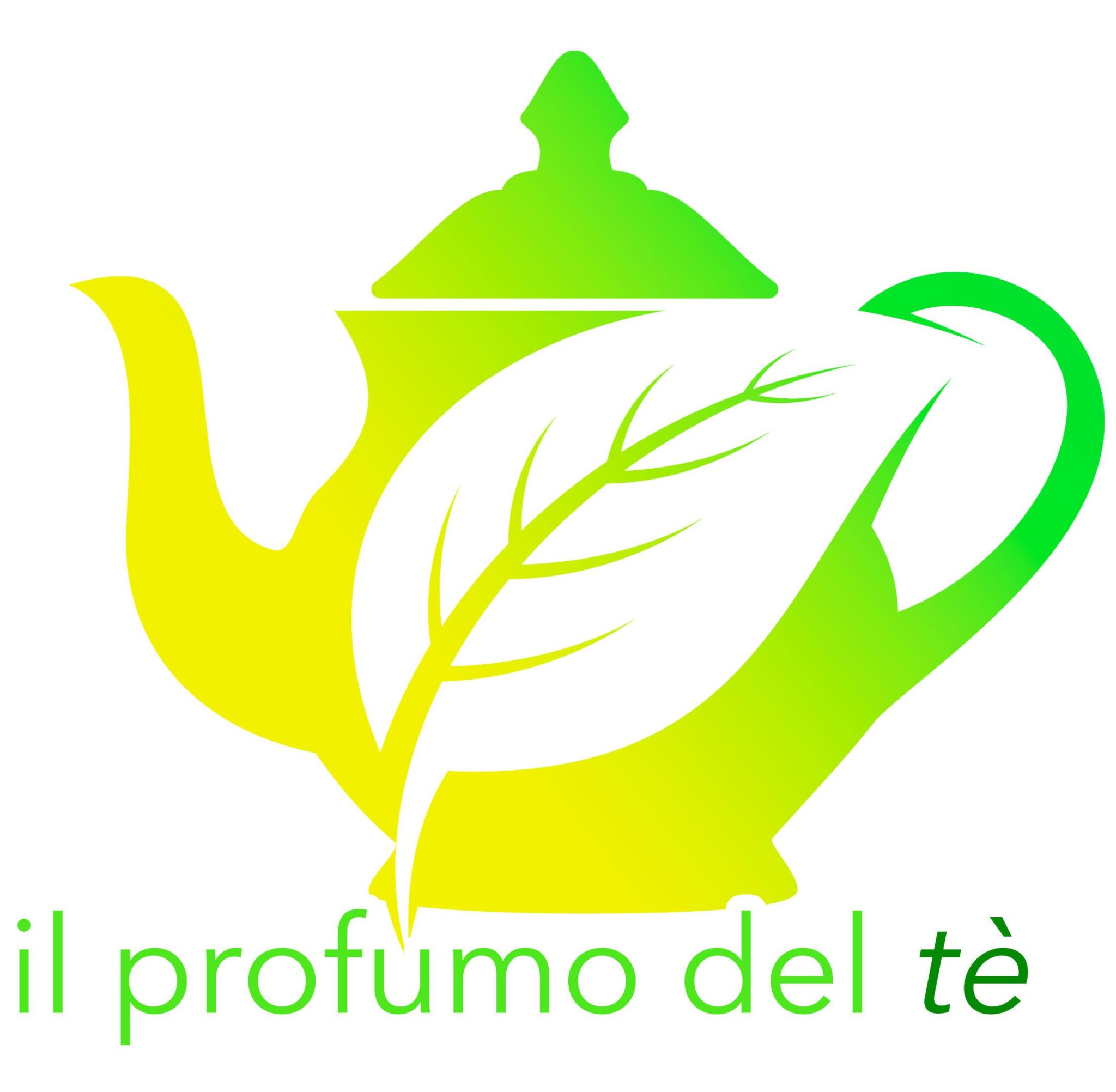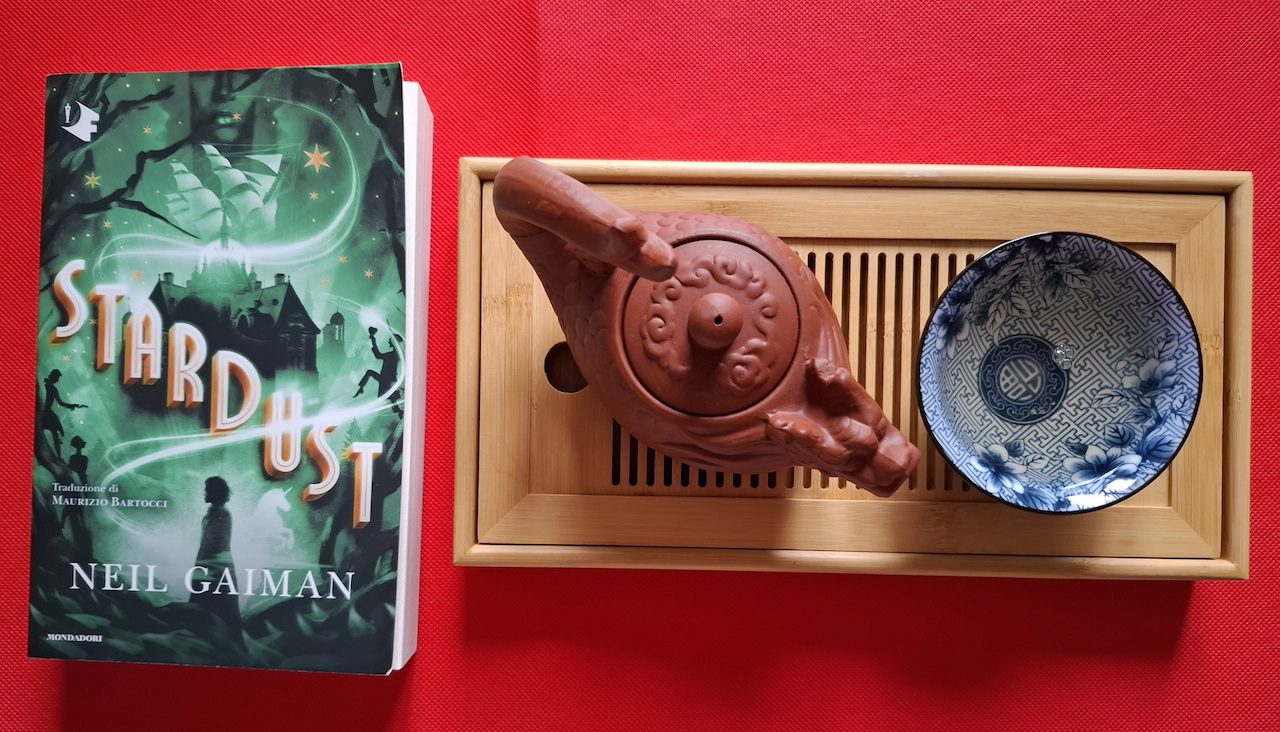Questo Natale è un po’ strano per me, difficile, complicato, interminabile, resiliente in cui alterno momenti di stress alla ricerca di soluzioni concrete, a momenti di breve serenità in cui posso concedermi di immergermi in una lettura fantasy o in un film, così da non pensare a questa vita a volte così dura.
Durante le festività il mondo fantastico è quasi di rito. Ecco allora che in questi giorni mi sono riletta “Stardust” di Neil Gaiman edito da Mondadori nell’ultima edizione del 2023. Non ho trovato l’edizione illustrata ormai limitatissima, ma è comunque ben fatta anche da un punto di vista grafico.
Questa fiaba non è decisamente per bambini, perché parla anche di tematiche adulte, ma è molto ben scritta. Mi piace come Gaiman ti immerge in un mondo fatto di paesaggi, profumi, cibi odorosi, pozioni magiche e personaggi incredibili.
La struttura è comunque quella tipica delle favole. Un garzone parte all’avventura per recuperare una “stella caduta” per la donna che desidera corteggiare, ma nel suo viaggio incontrerà antagonisti, ma anche nuovi amici, scoprirà chi è e da dove viene veramente, scoprirà che il suo vero amore è la stessa “stella” che voleva portare nel suo mondo.
Come in ogni storia fantasy che si rispetti la modalità è quella del “Viaggio dell’Eroe” di Joseph Campell. Ad un certo punto della nostra vita tutti abbiamo bisogno di scoprire chi siamo veramente e affrontare una qualche sfida, che ci farà diventare più forti e coraggiosi, per trovare la nostra vera missione nel mondo.
Per Tristan Thorn, il protagonista sarà diventare inaspettatamente, il Re di Stormhold assieme alla sua amata Stella.
Ci sono moltissimi archetipi esoterici. Chi non lo sapesse la parola “archetipo” rappresenta nella psicologia di Carl Gustav Jung, un’immagine, un simbolo o personaggio dell’immaginario collettivo che risiede anche nel nostro inconscio. Ciò significa possiamo utilizzare questi archetipi per lavorare su noi stessi e sul nostro percorso di vita.
In “Stardust” è molto presente l’archetipo della strega, che utilizza rune, pozioni, unguenti, bambole rituali, mutazioni pur di plasmare la realtà e raggiungere il suo obiettivo. Pensiamo sempre alle streghe come cattive, ma ci sono anche quelle amorevoli e guaritrici dotate di potenzialità incredibili e positive.
Lamia ha questa dualità nel suo lato luce e ombra, dove la sete di bellezza e immortalità la porta a utilizzare più quest’ultima per raggiungere il suo scopo e potersi cibare del cuore della Stella.
L’Unicorno è un altro simbolo bellissimo. Di solito è collegato non solo al mondo magico, ma anche a tutto ciò che è puro e incontaminato. Ho sempre amato gli unicorni, tanto che ne possiedo alcuni nella mia collezione, penso sia un’immagine potente di protezione. Infatti nel romanzo questo animale incantato salverà Yvaine (la Stella) e Tristan da morte certa.
La Stella mi ricorda l’archetipo XVII dei Tarocchi Marsigliesi, bionda, luminosa, pronta a risorgere e a donare al mondo il suo essere. La Luna archetipo XVIII è la sorella che rivelerà a Tristan come proteggerla dal male e lo farà attraverso i sogni.
Tra i metodi di divinazione, non compaiono i tarocchi ma bensì tipologie più nordiche come le Rune.
In un paio di capitoli compare il tè, quindi sicuramente almeno nel mondo degli uomini deve essere ambientato dopo il 1600. Il primo infuso Tristan lo beve con l’omino peloso del bosco vicino al ruscello a cui rivela che è in cerca di una stella per la sua amata e che viaggerà nel mondo di Faerie a lume di candela.
Quando infine avrà incontrato la sua Stella e se ne innamorerà cambierà idea, perché le proporrà di andare nel suo mondo, dove le verrà offerto un tè con il miglior servizio disponibile.
Il film tratto dal romanzo, diretto da Matthew Vaughn nel 2007, è molto ben fatto. Lo vidi al cinema appena uscì, ma devo dire che è sempre un piacere rivederlo anche a distanza di anni. Mi piace l’ambientazione vittoriana del mondo degli uomini, la colonna sonora sempre incalzante di Ilhan Eskeri, l’intreccio dei personaggi e le ambientazioni.
Il film è stato girato in Scozia e presso l’Isola di Skye dove andai molti anni fa. Una parte è stata girata anche in Islanda, altro bellissimo luogo che mi sarebbe sempre piaciuto visitare.
La pellicola è dotata di un grande cast, da una bellissima e bravissima Michelle Pfeiffer nel ruolo della strega Lamia, Claire Danes è invece Yvaine, Mark Strong, Henry Cavill, Rupert Everett, Ricky Gervais e Robert de Niro nel ruolo di Captain Shakespeare.
Sono una grande amante di Shakespeare e c’è un chiaro richiamo alla “Tempesta” e al tè. Infatti il nostro pirata è un po’ particolare, si atteggia in tutù ballando il can can mentre sorseggia un infuso, ma sarà fondamentale nel dare sostegno a Tristan e Yvaine nella loro avventura.
Tra i valori che vengono trasmessi c’è sicuramente quello dell’amore, non quello adolescenziale che Tristan prova per Victoria, ma quello vero e incondizionato che nasce da una profonda amicizia e reale conoscenza reciproca. Quello che non pretende ma semplicemente dona il suo cuore all’altro.

Stardust di Neil Gaiman edizione Mondadori del 2023 – Photo@Veru
“Stardust” in a magic world where you can drink tea

This Christmas is a bit strange for me, difficult, complicated, endless, resilient in which I alternate moments of stress in the search for concrete solutions, with moments of brief serenity in which I can allow myself to immerse myself in a fantasy reading or a film, so as not to think about this life that is sometimes so hard.
During the holidays the fantasy world is almost a ritual. So in these days I reread “Stardust” by Neil Gaiman published by Mondadori in the latest edition of 2023. I did not find the illustrated edition now very limited, but it is still well done also from a graphic point of view.
This fairy tale is definitely not for children, because it also talks about adult themes, but it is very well written. I like how Gaiman immerses you in a world made of landscapes, perfumes, fragrant foods, magic potions and incredible characters.
The structure is typical of fairy tales. A boy sets out on an adventure to recover a “fallen star” for the woman he wants to court, but on his journey he will meet antagonists, but also new friends, he will discover who he is and where he really comes from, he will discover that his true love is the same “star” he wanted to bring into his world.
As in every self-respecting fantasy story, the modality is that of Joseph Campell’s “Hero’s Journey”. At a certain point in our lives we all need to discover who we really are and face some challenge, which will make us stronger and braver, to find our true mission in the world.
For Tristan Thorn, the protagonist will unexpectedly become the King of Stormhold together with his beloved Stella.
There are many esoteric archetypes. For those who don’t know, the word “archetype” represents in the psychology of Carl Gustav Jung, an image, a symbol or character of the collective imagination that also resides in our unconscious. This means we can use these archetypes to work on ourselves and on our life path.
In “Stardust” the archetype of the witch is very present, who uses runes, potions, ointments, ritual dolls, mutations in order to shape reality and achieve her goal. We always think of witches as evil, but there are also loving and healing ones with incredible and positive potential.
Lamia has this duality in her light and shadow side, where the thirst for beauty and immortality leads her to use the latter more to achieve her goal and be able to feed on the heart of the Star.
The Unicorn is another beautiful symbol. It is usually connected not only to the magical world, but also to everything that is pure and uncontaminated. I have always loved unicorns, so much so that I have some in my collection, I think it is a powerful image of protection. In fact in the novel this enchanted animal will save Yvaine (the Star) and Tristan from certain death.
The Star reminds me of the archetype XVII of the Tarot of Marseilles, blonde, bright, ready to rise again and give her being to the world. The Moon archetype XVIII is the sister who will reveal to Tristan how to protect her from evil and will do so through dreams.
Among the divination methods, tarot cards do not appear but rather more Nordic types such as Runes.
Tea appears in a couple of chapters, so surely at least in the world of men it must be set after 1600. Tristan drinks the first infusion with the little hairy man in the woods near the stream to whom he reveals that he is looking for a star for his beloved and that he will travel in the world of Faerie by candlelight.
When he finally meets his Star and falls in love with her, he will change his mind, because he will propose to go to his world, where she will be offered a tea with the best service available.
The film based on the novel, directed by Matthew Vaughn in 2007, is very well done. I saw it at the cinema as soon as it came out, but I must say that it is always a pleasure to see it again even after many years. I like the Victorian setting of the man’s world, the ever-inspiring score by Ilhan Eskeri, the intertwining of characters and the settings.
The film was shot in Scotland and on the Isle of Skye where I went many years ago. Part of it was also shot in Iceland, another beautiful place that I would have always liked to visit.
The film has a great cast, from a beautiful and talented Michelle Pfeiffer in the role of the witch Lamia, Claire Danes is instead Yvaine, Mark Strong, Henry Cavill, Rupert Everett, Ricky Gervais and Robert de Niro in the role of Captain Shakespeare.
I am a great lover of Shakespeare and there is a clear reference to “The Tempest” and tea. In fact, our pirate is a bit particular, he poses in a tutu dancing the can can while sipping an infusion, but he will be fundamental in giving support to Tristan and Yvaine in their adventure.
Among the values that are transmitted there is certainly that of love, not the adolescent one that Tristan feels for Victoria, but the true and unconditional one that comes from a deep friendship and real mutual knowledge. The one who doesn’t demand but simply gives his heart to the other.



No responses yet